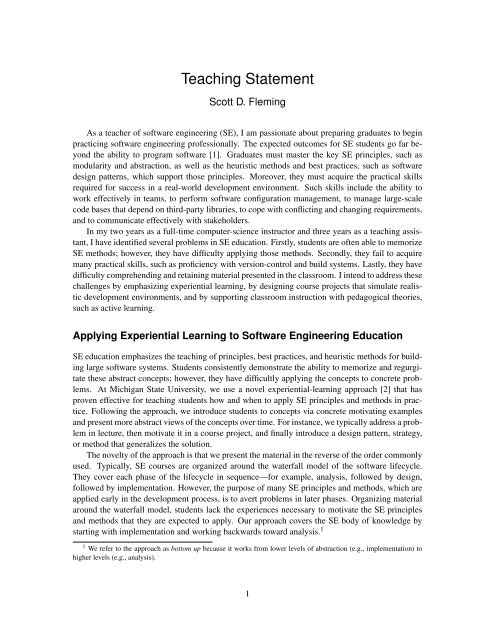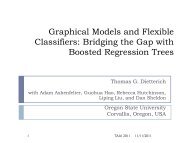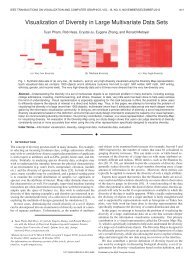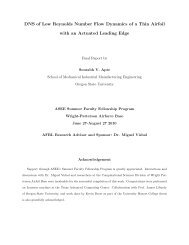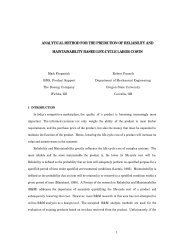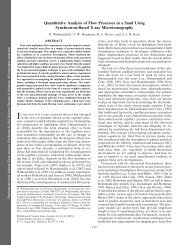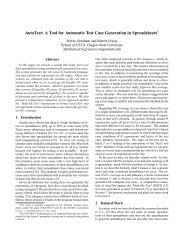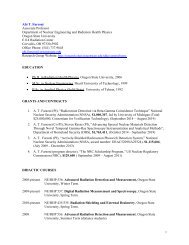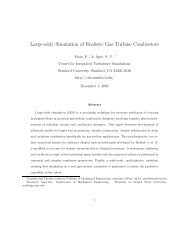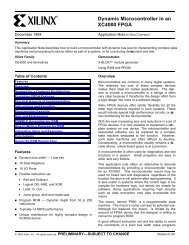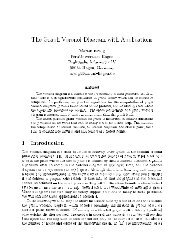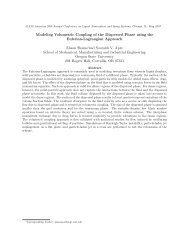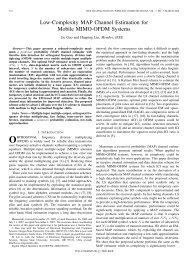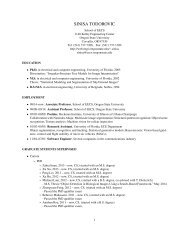full teaching statement - College of Engineering
full teaching statement - College of Engineering
full teaching statement - College of Engineering
Create successful ePaper yourself
Turn your PDF publications into a flip-book with our unique Google optimized e-Paper software.
Teaching Statement<br />
Scott D. Fleming<br />
As a teacher <strong>of</strong> s<strong>of</strong>tware engineering (SE), I am passionate about preparing graduates to begin<br />
practicing s<strong>of</strong>tware engineering pr<strong>of</strong>essionally. The expected outcomes for SE students go far beyond<br />
the ability to program s<strong>of</strong>tware [1]. Graduates must master the key SE principles, such as<br />
modularity and abstraction, as well as the heuristic methods and best practices, such as s<strong>of</strong>tware<br />
design patterns, which support those principles. Moreover, they must acquire the practical skills<br />
required for success in a real-world development environment. Such skills include the ability to<br />
work effectively in teams, to perform s<strong>of</strong>tware configuration management, to manage large-scale<br />
code bases that depend on third-party libraries, to cope with conflicting and changing requirements,<br />
and to communicate effectively with stakeholders.<br />
In my two years as a <strong>full</strong>-time computer-science instructor and three years as a <strong>teaching</strong> assistant,<br />
I have identified several problems in SE education. Firstly, students are <strong>of</strong>ten able to memorize<br />
SE methods; however, they have difficulty applying those methods. Secondly, they fail to acquire<br />
many practical skills, such as pr<strong>of</strong>iciency with version-control and build systems. Lastly, they have<br />
difficulty comprehending and retaining material presented in the classroom. I intend to address these<br />
challenges by emphasizing experiential learning, by designing course projects that simulate realistic<br />
development environments, and by supporting classroom instruction with pedagogical theories,<br />
such as active learning.<br />
Applying Experiential Learning to S<strong>of</strong>tware <strong>Engineering</strong> Education<br />
SE education emphasizes the <strong>teaching</strong> <strong>of</strong> principles, best practices, and heuristic methods for building<br />
large s<strong>of</strong>tware systems. Students consistently demonstrate the ability to memorize and regurgitate<br />
these abstract concepts; however, they have difficultly applying the concepts to concrete problems.<br />
At Michigan State University, we use a novel experiential-learning approach [2] that has<br />
proven effective for <strong>teaching</strong> students how and when to apply SE principles and methods in practice.<br />
Following the approach, we introduce students to concepts via concrete motivating examples<br />
and present more abstract views <strong>of</strong> the concepts over time. For instance, we typically address a problem<br />
in lecture, then motivate it in a course project, and finally introduce a design pattern, strategy,<br />
or method that generalizes the solution.<br />
The novelty <strong>of</strong> the approach is that we present the material in the reverse <strong>of</strong> the order commonly<br />
used. Typically, SE courses are organized around the waterfall model <strong>of</strong> the s<strong>of</strong>tware lifecycle.<br />
They cover each phase <strong>of</strong> the lifecycle in sequence—for example, analysis, followed by design,<br />
followed by implementation. However, the purpose <strong>of</strong> many SE principles and methods, which are<br />
applied early in the development process, is to avert problems in later phases. Organizing material<br />
around the waterfall model, students lack the experiences necessary to motivate the SE principles<br />
and methods that they are expected to apply. Our approach covers the SE body <strong>of</strong> knowledge by<br />
starting with implementation and working backwards toward analysis. 1<br />
1 We refer to the approach as bottom up because it works from lower levels <strong>of</strong> abstraction (e.g., implementation) to<br />
higher levels (e.g., analysis).<br />
1
With our approach, students demonstrate improved ability to apply SE principles and methods<br />
to new situations. By first giving students experiences that epitomize abstract concepts, they are<br />
better able to understand the applicability <strong>of</strong> the concepts. By working backwards through the<br />
development process, we are able to motivate methods whose benefits are only realized during later<br />
phases <strong>of</strong> the process. Given our success with the approach, I intend to continue refining it by<br />
developing new materials, such as sample programs and libraries, and by incorporating innovative<br />
<strong>teaching</strong> techniques, such as collaborative learning.<br />
Covering Practical Skills<br />
Preparation for real-world s<strong>of</strong>tware development environments requires learning practical skills,<br />
such as configuration management and working with third-party libraries. Covering many <strong>of</strong> these<br />
practical skills in the context <strong>of</strong> a college course is difficult. SE principles and methods are conceptually<br />
rich and require extensive coverage in lecture. However, the practical skills tend to be rote in<br />
nature and warrant little or no coverage. Mastering such skills requires thorough practice. So then,<br />
the problem is how to integrate such practice into a course without expending valuable class time.<br />
I address this problem by infusing elements <strong>of</strong> realism into course projects. Such elements<br />
provide students with practice in practical aspects <strong>of</strong> s<strong>of</strong>tware development. In essence, my goal is<br />
to produce realistic simulations <strong>of</strong> real-world development environments. My <strong>teaching</strong> and research<br />
dovetails with respect to this goal. In my empirical research, I aim to produce realistic simulations<br />
for the purpose <strong>of</strong> studying developers in a laboratory setting (e.g., [3]). The lessons learned and<br />
artifacts produced by developing simulations in one context (e.g., research) naturally transfer to the<br />
other (e.g., <strong>teaching</strong>).<br />
For example, I designed a course project for a junior-level s<strong>of</strong>tware-design course at Michigan<br />
State University. The project involves extending the functionality <strong>of</strong> a multithreaded GUI browser<br />
application. I incorporated several elements <strong>of</strong> realism into the project. Firstly, the browser is small<br />
(1695 SLOC) but has a realistic model-view-controller architecture [4]. Secondly, students must<br />
program against three third-party libraries, FLTK 2 , ACE 3 , and a library <strong>of</strong> reusable abstractions<br />
specifically created for the course. Lastly, students are required to use a version-control system,<br />
CVS 4 , to check out the source code and commit incremental changes. These elements require<br />
minimal class time to explain and provide students with valuable practice for the real world.<br />
Applying Pedagogical Theories in the Classroom<br />
I endeavor to provide top-notch instruction to students. To this end, I continually look to the literature<br />
on education for new classroom strategies and techniques. For example, two pedagogical<br />
theories that I incorporate in my <strong>teaching</strong> are active learning and individual learning styles.<br />
Active learning emphasizes actively engaging students in course material [5]. Studies consistently<br />
show that passively listening to traditional didactic lectures is not conducive to student<br />
learning [5]. Students’ ability to assimilate knowledge drops <strong>of</strong>f sharply after roughly 20 minutes<br />
<strong>of</strong> continuous lecturing. To implement active learning, I break up my lectures into 20-minute<br />
2 http://www.fltk.org<br />
3 http://www.cs.wustl.edu/˜schmidt/ACE.html<br />
4 http://www.nongnu.org/cvs/<br />
2
mini-lectures, interspersed with short (e.g., 5–10 minutes) activities. The types <strong>of</strong> activities include<br />
reading, writing, problem solving, and discussion. For example, I frequently use Think-Pair-Share<br />
activities [6]. During one mini-lecture, I introduce a problem, such as how to make a buffer threadsafe.<br />
Next, I ask students to think silently about a solution. Then, I ask them to pair up with a<br />
partner to compare and discuss their solutions. Finally, I randomly select a student to describe her<br />
solution or to summarize her discussion. 5<br />
I am also sensitive to individual differences in the learning styles that students favor. For example,<br />
some students are visual learners, which means they prefer to work with information in the<br />
form <strong>of</strong> pictures and text enhanced with color and layout [7]. Other students are aural learners,<br />
which means they prefer to process information verbally, for example, by listening or engaging in<br />
conversation. Although no student is restricted to just one learning style, students may have strong<br />
preferences toward some styles and struggle with others. Given such individual differences, I try to<br />
present information in as wide a variety <strong>of</strong> styles as possible. For example, in my lectures, I augment<br />
my aural presentations with visual aids, such as UML diagrams, graphs, and animations. Moreover,<br />
in-class activities provide an excellent opportunity to support a variety <strong>of</strong> learning styles, such as<br />
those that favor conversation or reading/writing. Being sensitive to variations in learning style helps<br />
ensure a learning environment that is fair for all learners and improves student performance in the<br />
aggregate.<br />
Engaging Students in Research<br />
I firmly believe in the value <strong>of</strong> engaging students in research. Students benefit from such involvement<br />
by being exposed to new methods and technologies, by learning about how research is conducted<br />
in general, and by gaining firsthand insight into a potential career path in research. The<br />
research community benefits by promoting the value <strong>of</strong> SE research to future SE pr<strong>of</strong>essionals, by<br />
increasing access to qualified study participants, and by recruiting new researchers.<br />
I engage students in my research by inviting them to participate in studies (e.g., [3]). Students<br />
make excellent subjects <strong>of</strong> study. They represent an important subpopulation <strong>of</strong> s<strong>of</strong>tware engineers,<br />
and recruiting students for pilot studies is convenient and cost effective. In addition to compensating<br />
students fairly for their participation in studies, they benefit by being introduced to new SE concepts<br />
and technologies, or by getting additional practice with familiar concepts. Furthermore, students<br />
receive a debriefing in which they learn about the design and findings <strong>of</strong> the study. Students can<br />
also serve as assistants who help conduct research studies. The NSF Research Experiences for<br />
Undergraduates (REU) program provides supplemental funding for on-going NSF grants to pay<br />
such assistants.<br />
Course Preferences<br />
I look forward to <strong>teaching</strong> graduate-level courses in s<strong>of</strong>tware engineering, formal methods, empirical<br />
methods, and distributed systems, as well as seminar courses on special topics, such as<br />
concurrent programming models and empirical s<strong>of</strong>tware engineering. I am qualified to teach most<br />
undergraduate computer-science courses and have a preference toward s<strong>of</strong>tware engineering, empirical<br />
methods, distributed systems, and compilers.<br />
5 Random selection ensures that students are individually accountable for participating.<br />
3
References<br />
[1] ACM/IEEE-CS Joint Task Force on Computing Curricula, “S<strong>of</strong>tware <strong>Engineering</strong> 2004: Curriculum<br />
Guidelines for Undergraduate Degree Programs in S<strong>of</strong>tware <strong>Engineering</strong>,” August 2004, http://sites.<br />
computer.org/ccse/SE2004Volume.pdf.<br />
[2] R. E. K. Stirewalt, “Teaching s<strong>of</strong>tware engineering bottom up,” in Proc. 2004 American Society for<br />
<strong>Engineering</strong> Education Annual Conference & Exposition, 2004.<br />
[3] S. D. Fleming, E. Kraemer, R. E. K. Stirewalt, S. Xie, and L. K. Dillon, “A study <strong>of</strong> student strategies<br />
for the corrective maintenance <strong>of</strong> concurrent s<strong>of</strong>tware,” in Proc. 30th Int’l Conf. S<strong>of</strong>tware <strong>Engineering</strong><br />
(ICSE ’08 Education Track), 2008, pp. 759–768.<br />
[4] G. E. Krasner and S. T. Pope, “A cookbook for using the model-view-controller user interface paradigm<br />
in Smalltalk-80,” J. Object Oriented Programming, vol. 1, no. 3, pp. 26–49, 1988.<br />
[5] C. C. Bonwell and J. A. Eison, Active Learning: Creating Excitement in the Classroom, ser. ASHE-<br />
ERIC Higher Education Report No. 1. Washington, D.C.: The George Washington University, School<br />
<strong>of</strong> Education and Human Development, 1991.<br />
[6] F. T. Lyman, “The responsive classroom discussion: The inclusion <strong>of</strong> all students.” in Mainstreaming<br />
Digest, A. Anderson, Ed. Univ. Maryland Press, 1981, pp. 109–113.<br />
[7] N. D. Fleming, “I’m different; not dumb: Modes <strong>of</strong> presentation (V.A.R.K.) in the tertiary classroom,”<br />
in Proc. 1995 Annu. Conf. <strong>of</strong> the Higher Education and Research Development Society <strong>of</strong> Australasia<br />
(HERDSA ’95), 1995, pp. 308–313.<br />
4


